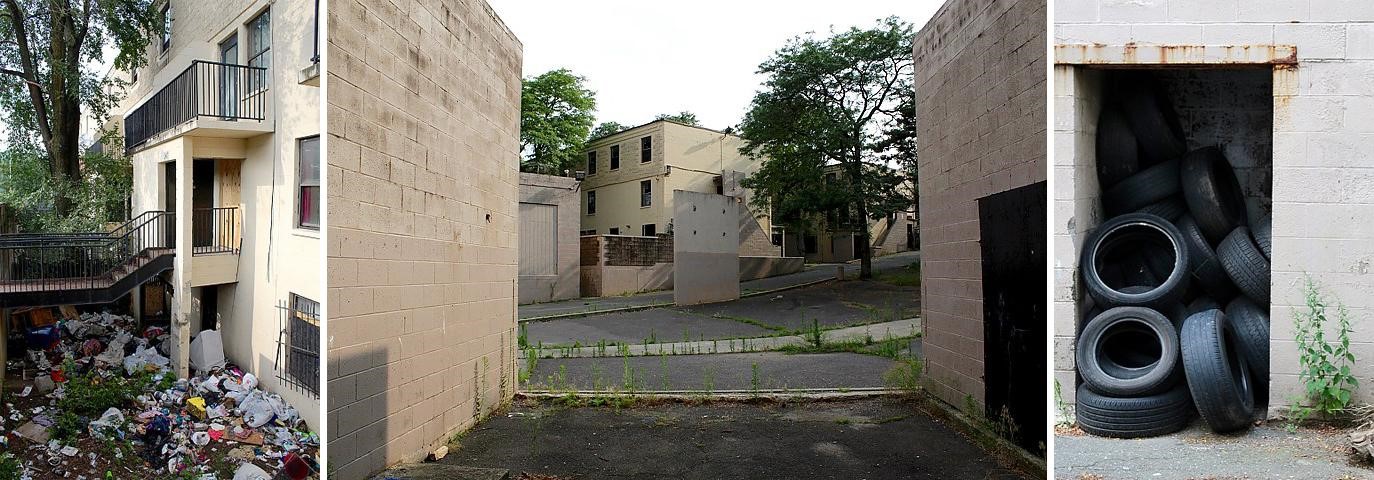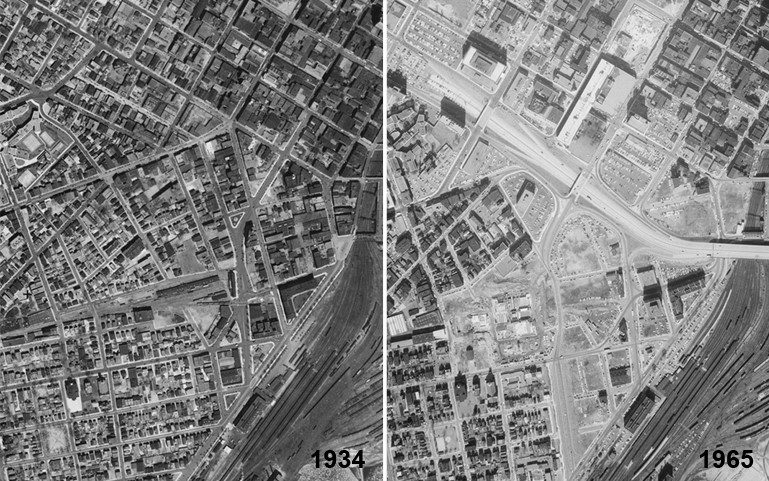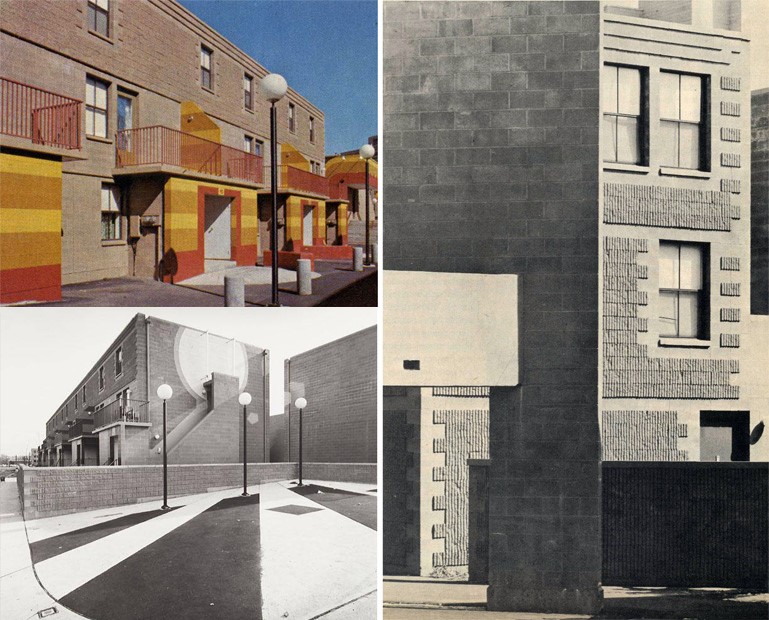Local Area News: History Repeating: The Redevelopment of New Haven’s Church Street
Contributor
Audience
JONATHAN HOPKINS (M.E.D. ’19)
“You sometimes wonder – why did they do that? For redevelopment proposes they did that.”
Church Street South Housing is a 301-unit project-based low-income residential development in New Haven built in 1969 and designed by former YSOA Dean Charles Moore. Today, the complex is almost entirely vacant except for a few families awaiting imminent relocation to other apartments in the area. The three- and four-story concrete block buildings sit between a burgeoning medical district around Amistad Park containing the nation’s ninth largest hospital, a rapidly developing Downtown district, and Union Station, the sixteenth busiest Amtrak station in the US, which serves the third busiest passenger railroad service in the country.[1]
At the time of its completion, Moore’s design received generous praise from various critics. “Progressive Architecture” gave the development a cover story in its May 1972 issue. Don Metz, an architect and author, declared the complex “a cohesive urban environment.” And venerable New Haven architectural historian Elizabeth Mills Brown called Church Street South Housing “a civilized urban environment [with] much to study and enjoy.”

Views of a largely vacated Church Street South Housing in 2017 (New Haven Independent)
By 2015, when a coordinated relocation effort of 288 existing households began, Church Street South Housing had suffered from nearly five decades of deferred maintenance, leaving the project in a state of severe deterioration. That same year, Northland Investment Corporation, the Massachusetts-based real estate firm that has owned Church Street South Housing since 2008, stated in a report that “based on the challenges facing the building structures and their obsolescence it makes no economic sense to repair and/or replace the deficiencies in an ad hoc or piecemeal fashion or, for that matter, in their entirety. Furthermore, it would not be in the best interests of the residents as any meaningful reconstruction would be tantamount to new construction and be a long-term undertaking (i.e. years).” The statement goes on to claim that “any money invested for the benefit of the Church Street South families would be better spent in relocation costs to find them suitable, alternative housing.”[2]
Moreover, HUD spokeswoman Rhonda Siciliano deemed the residential complex as “functionally obsolete and probably more cost effective to tear down and replace.” However, according to a 2016 New Haven Independent news article, individuals still residing in Church Street South, reported having no immediate plan to move out despite it having been deemed uninhabitable. One woman in particular who, after living at Church Street South with her three children for 15 years, had “never had a problem” and said her apartment was “in good condition”.[3] Nevertheless, the property owner, city officials, and relocation service providers at the Housing Authority of New Haven have decided that all tenants must be forcibly relocated to alternative housing.
As of January 2018, after more than two years of daunting relocation efforts, nearly all households from the complex have move out. Some residents preemptively relocated on their own into the private rental market. Others moved to new project-based complexes in the area. Most transferred their project-based rental vouchers to the portable Section 8 voucher program accepted by private landlords throughout the New Haven area. For some, the move likely represented an improvement in accommodations, but for many, relocation has been devastating. Some had to settle for smaller residences farther from the city center and its resources, others moved into one of the many slumlord-owned properties in the area, and still others moved back to Puerto Rico to live with families only to be welcomed by Hurricane Maria this past summer.[4]
Northland Investment’s most recent plans for redeveloping the site, released in July of 2016, depict the 12-acre parcel being replaced with nearly 700 structured parking spaces, 25,000 square feet of commercial retail space, and over 1,000 residential units in a series of perimeter-block, 5-story stick-frame corridor buildings. The City of New Haven, through the Livable City Initiative, applied for a $30 Million grant from HUD to reserve 30% of this new development as “affordable units”, while the rest will be market rate.[5]
The story of Church Street South Housing is, in many ways, tragic. The once acclaimed design was never adequately maintained by its owners. The low-income, largely Spanish-speaking population of Puerto Rican heritage, was required to disperse from their center city apartments to wherever alternative housing happened to be available, which was often in disparate locations. And the story is made all the more tragic when considering the site’s history.

Aerial photographs of New Haven’s former warehouse district between Union Station and the Green in 1934 (left) and 1965 (right) (Map and Geographic Information Center, University of Connecticut)
As part of the Church Street Redevelopment Project, Church Street South Housing was built at the tail end of New Haven’s Urban Redevelopment program, a federally-funded initiative enabled by the 1949 Housing Act. Declared a slum by city officials, federal funds subsidized the acquisition, condemnation, and demolition of an entire district in New Haven’s center without a definitive plan, clear goals, or guaranteed financing for new construction. Referring to the former warehouse district and working class neighborhood that the Church Street Redevelopment Project sought to replace, Richard C. Lee, mayor of New Haven from 1954 to 1970, recounted:
“The buildings that were used were obsolete and inefficient, relics of a bygone age. Streets were too often littered with refuse and filth and infested with rats and vermin. This was the sight that greeted visitors to New Haven as they left the railroad station. One can hardly imagine a less impressive entrance to a city.”[6]
According to a former resident of the redevelopment project area, Harry DeBenedet, however, “the buildings were [structurally] sound and it was a nice neighborhood. It was a safe area and they knocked my house down [and] you sometimes wonder – why did they do that? Everything was fine there. It wasn’t a problem. For redevelopment proposes they did that.”[7] At the time, New Haven city officials didn’t deny that suitable housing stock was being demolished; they viewed the loss as a necessary means to meet a larger goal. In reference to the adjacent Oak Street Redevelopment Project, the New Haven Redevelopment Agency stated that “not every structure in this area is sub-standard, but like cutting a rotten spot from an apple, some of the good has to be cut away to to save the whole.”[8] So while mid-century planners may have agreed that not all structures in the Church Street area required replacement, they nevertheless justified total clearance and new construction as was then stipulated by the Housing Act.

Photographs of Church Street South Housing soon after its completion in the early 1970s (Progressive Architecture, May 1972)
The Church Street South Housing site was originally planned for private commercial development, but when there was no market interest to support that plan. As a result, the program was changed to housing funded through Section 122 of the Federal Housing Administration and parks financed by “federal recreational funding”, despite the entire premise of the Urban Redevelopment program being that subsidizing acquisition, demolition, and parcel bundling costs would entice private market investment.[9] Furthermore, scores of residents were relocated from their homes to other areas of the city. Some were moved to neighborhoods subsequently targeted for redevelopment, resulting in a second displacement for those households.[10] Ultimately, 707 households were displaced from the Church Street Redevelopment Project in the mid-20th century.
The issues associated with Urban Redevelopment Projects like Church Street in New Haven influenced amendments made to the Housing Act in 1954, which provided funding for rehabilitation and preservation work as an alternative to widespread clearance and redevelopment. This lesson – learned over 65 years ago – has seemingly been forgotten as evidenced by the recent tragedy of Church Street South Housing, the very Urban Redevelopment project from which the lesson was originally derived. One is left to wonder how the residents and buildings of Northland’s new redevelopment project will fare in 50 years time. In closing, a former resident of Church Street South Housing, Babz Rawls-Ivy, said of her childhood home:
“It was a beautiful place – it was a lovely, lovely place. It was very colorful. We knew everybody; we knew families. There was a grocery store, there was a dry cleaners, there was a pharmacy, there was a daycare center – I mean it was amazing – there were fountains with water, there was grass everywhere and flowers. It was well lit – it was beautiful. We had a larger family; we had four kids and a mother and father and we had an up-down unit with two bathrooms and a yard and the whole thing. I thought the design was amazing – it fostered a sense of community.”[11]
[1] Kelly Gooch. 25 largest hospitals in America “Becker’s Hospital Review” (January 18, 2017)
Paul Bass. 2018: Hotels Rising, Not At Coliseum Site “New Haven Independent” (January 3, 2018)
Amtrak. “National Fact Sheet: FY 2015” (February 2016)
American Public Transportation Association. “Public Transportation Ridership Report Fourth Quarter 2016” (March 3, 2017)
[2] Northland Investment Corporation. “Operational Decommissioning Plan” (2015)
[3] Brian Slattery. Church Street South Demolition Begins “New Haven Independent” (March 21, 2016)
[4] Paul Bass. Slumlord Doc Bails, Profits “New Haven Independent” (April 22, 2016)
Robinson Meyer. What’s Happening With the Relief Effort in Puerto Rico? “The Atlantic” (October 4, 2017)
[5] Allan Appel. Church St. South, 9th Sq. Plans Advance “New Haven Independent” (November 22, 2017)
[6] Remarks of Mayor Richard C. Lee at Citizens Action Commission Annual Meeting, April, 24, 1965, Series XVIII: Projects, New Haven Redevelopment Agency Records, Group 1814, Box 396: Planning and Plan Amendments, Manuscripts and Archives, Yale University, New Haven. From Emily Dominski. “A Nowhere Between Two Somewheres: The Church Street South Project and Urban Renewal in New Haven” (2012). MSSA Kaplan Prize for Use of MSSA Collections. Paper 7.
[7] New Haven Oral History Project. Harry DeBenedet “Life in the Model City: Stories of Urban Renewal in New Haven” (The Community Foundation for Greater New Haven, 2004)
[8] Alexis Zanghi. Making A Better City Out of ‘Model City’ “City Lab” (September 28, 2016)
[9] Gerald Allen. Church Street South “Monographs on Contemporary Architecture: Charles Moore” (Whitney Library of Design; 1980) p. 60
[10] Adrien A. Weibgen. “There Goes the Neighborhood: Slums, Social Uplift, and the Remaking of Wooster Square” (2013). Student Legal History Papers. Paper 24
[11] Paul Bass, et al. Dateline New Haven: Friday Pundit Panel “WNHH Community Radio” (Episode 6, 2015)